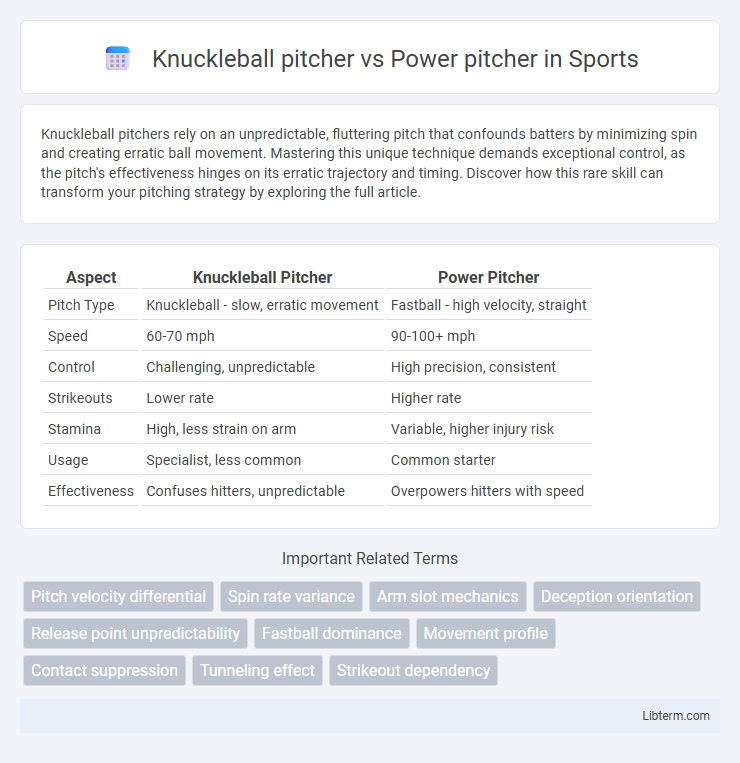Knuckleball pitchers rely on an unpredictable, fluttering pitch that confounds batters by minimizing spin and creating erratic ball movement. Mastering this unique technique demands exceptional control, as the pitch's effectiveness hinges on its erratic trajectory and timing. Discover how this rare skill can transform your pitching strategy by exploring the full article.
Table of Comparison
| Aspect | Knuckleball Pitcher | Power Pitcher |
|---|---|---|
| Pitch Type | Knuckleball - slow, erratic movement | Fastball - high velocity, straight |
| Speed | 60-70 mph | 90-100+ mph |
| Control | Challenging, unpredictable | High precision, consistent |
| Strikeouts | Lower rate | Higher rate |
| Stamina | High, less strain on arm | Variable, higher injury risk |
| Usage | Specialist, less common | Common starter |
| Effectiveness | Confuses hitters, unpredictable | Overpowers hitters with speed |
Introduction: Knuckleball Pitchers vs Power Pitchers
Knuckleball pitchers specialize in throwing an unpredictable, slow-moving pitch that confuses batters with its erratic flight path, relying on finesse and deception rather than velocity. Power pitchers dominate with fast, high-velocity pitches, often exceeding 95 mph, using sheer speed and aggressive pitching mechanics to overpower hitters. The contrast between these styles highlights varying strategic approaches in baseball, emphasizing control and movement versus raw power and velocity.
Defining the Knuckleball Pitcher
A knuckleball pitcher specializes in throwing a knuckleball, a slow, unpredictable pitch with minimal spin that confuses hitters and catchers alike, causing erratic movement. Unlike power pitchers who rely on velocity and fastballs often exceeding 90 mph to overpower batters, knuckleballers use finesse and deception, with pitch speeds typically ranging from 55 to 70 mph. This unique pitching style demands exceptional control and timing, making knuckleball pitchers rare and highly valuable for disrupting offensive rhythms.
Characteristics of a Power Pitcher
Power pitchers rely on fastball velocity, often exceeding 95 mph, to overpower hitters with sheer speed and aggressive pitch placement. Their pitching arsenal typically includes high-velocity fastballs, sharp sliders, and dominating curveballs that emphasize strikeouts through movement and velocity. Exceptional arm strength, explosive mechanics, and the ability to maintain velocity deep into games distinguish power pitchers from knuckleballers.
Pitching Mechanics: Knuckleball vs Power
Knuckleball pitchers utilize minimal wrist and finger movement to release a nearly spinless ball, relying on unpredictable airflow for movement, while power pitchers generate velocity through explosive leg drive, strong hip rotation, and a forceful wrist snap. The knuckleball pitching mechanics emphasize finesse and control, focusing on grip and release to maximize flutter and erratic trajectory. In contrast, power pitchers depend on kinetic chain efficiency, coordinating lower body strength and upper body torque to achieve high-speed fastballs.
Velocity vs Movement: Contrasting Approaches
Knuckleball pitchers rely on minimal velocity, typically around 60-70 mph, to create unpredictable movement that confounds hitters with erratic, fluttering trajectories. Power pitchers generate significantly higher velocity, often exceeding 95 mph, leveraging speed to overpower batters and reduce reaction time. The knuckleball's success depends on subtle airflow disruptions that cause movement, whereas power pitchers emphasize straight, high-velocity fastballs with occasional sharp-breaking pitches.
Control and Command Differences
Knuckleball pitchers rely on unpredictable movement and finesse, resulting in less consistent control but requiring exceptional command to locate pitches within the strike zone. Power pitchers generate velocity and rely on command to consistently hit precise spots, maximizing strikeouts with fewer pitches outside the zone. The knuckleball's erratic flight challenges control metrics, whereas power pitchers leverage repeatable mechanics to maintain tighter control over pitch location.
Historical Success Stories
Knuckleball pitchers like Tim Wakefield and Phil Niekro achieved prolonged careers by baffling hitters with unpredictable pitch movement, contributing to multiple playoff successes. Power pitchers such as Nolan Ryan and Randy Johnson dominated with high-velocity fastballs combined with sharp breaking balls, earning numerous strikeout records and MVP awards. Historical success stories showcase how contrasting pitching styles can excel in Major League Baseball based on strategy, adaptability, and physical attributes.
Career Longevity Comparison
Knuckleball pitchers often experience longer careers than power pitchers due to the reduced stress their unique pitch places on the arm, allowing them to maintain effectiveness even into their 40s. Power pitchers rely heavily on velocity, which naturally declines with age and increases injury risk, typically shortening their career span. Historical data shows knuckleballers like Phil Niekro and Tim Wakefield remaining competitive for over two decades, contrasting with power pitchers whose peak performance windows tend to be much shorter.
Challenges Faced by Each Pitching Style
Knuckleball pitchers face challenges such as controlling the unpredictable movement of the ball, which often leads to higher walk rates and requires exceptional catcher skills for successful framing. Power pitchers must overcome fatigue and maintain velocity to dominate hitters while managing a higher risk of arm injuries due to repetitive high-effort throwing. Both styles demand unique physical and mental adaptations to optimize performance and contribute effectively to their teams.
The Future of Knuckleball and Power Pitchers in Baseball
Knuckleball pitchers are experiencing a niche resurgence as teams seek unpredictable pitching styles to counter increasingly powerful hitters, blending craft and deception to disrupt timing. Power pitchers continue to dominate with velocity and strikeout ability, fueled by advancements in biomechanics and training technologies that enhance pitch speed and endurance. The future of baseball pitching likely involves a hybrid approach, integrating knuckleball's movement unpredictability with power pitching's intensity to adapt to evolving offensive strategies.
Knuckleball pitcher Infographic

 libterm.com
libterm.com